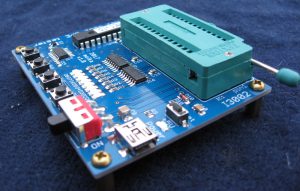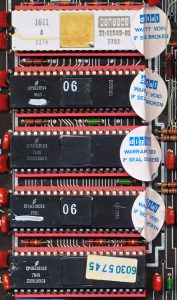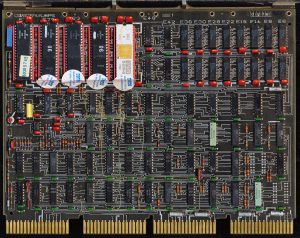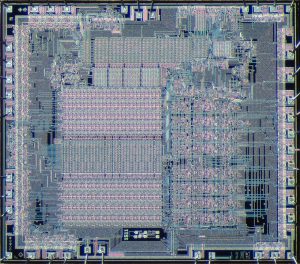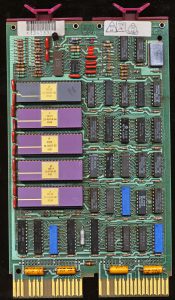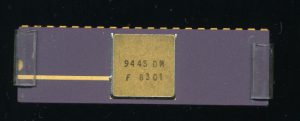
Fairchild 9445DM – 1983 Military Temp Range
In the 1970’s many companies began to make processors based on mainframe architectures of the time. Data General with the creation of the mN601 MicroNova, TI with the TMS9900, DEC with the LSI-11 and others. This set the stage for a pretty large showdown, as what happens when a company other then the original mainframe company creates a processor that is compatible? This is what began to happen in the late 1970’s, and with the release of Fairchild F9440 MICROFLAME. We’ll quote directly from the F9440 datasheet “Though structurally different from the CPUs of the Data General NOVA line of minicomputers, the 9440 offers comparable performance and executes the same instruction set.” Specifically the bi-polar F9440 could
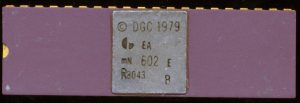
DGC mN602E – MicroNova – Data Generals Own single chip Nova
run most the code from the very popular Data General Nova 2 computer system. Obviously, as Fairchild states, it is structurally different, as its Fairchilds own hardware LSI implementation. The idea that an instruction set could be copyrighted was already being tested, and by all appearances at the time it was assumed that an Instruction set, could not be copyrighted. This certainly helped in the wide adoption late on of x86. A different way of protecting computer architectures had to be created then.
The first salvo was fired by Data General, in a lawsuit claiming that Fairchild’s F9440 enticed DG users to break their software license agreements. DG’s way of ensuring they had control of their customers was to add a section in the software license agreement that the software could ONLY be ran on Data General hardware, even if it COULD run on a Fairchild F9440 (or any other hardware) it was a violation of the license to do so. In 1978 Fairchild counter-sued, claiming that such a license was anti-competitive and seeking $10 Million in damages as a result of DG’s original suit.
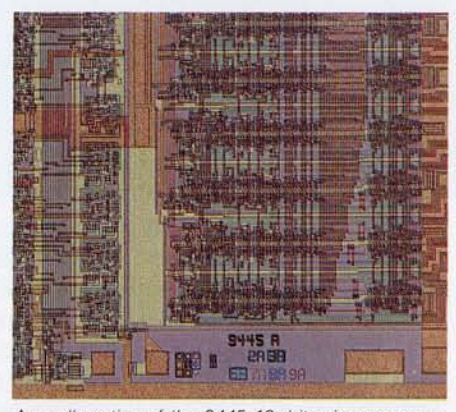
9445 DIe shot (partial)
To add fuel to the fire, Fairchild announced the F9445, the MICROFLAME II. The F9445 was built with the same I3L (Isoplanar Integrated Injection Logic) technology but on a 2-Micron process instead of the 3-Micron process of the 9440 and contained over 5000 gates. The F9445 could was compatible with the Nova 3 and Fairchild claimed it would be 10 times faster then the Nova 3. The F9445 was announced in 1978 but development issues (this was one of the largest, fastest bi-polar designs) took some time and led to many delays. In 1979 Fairchild, low on cash, was purchased by Schlumberger Limited, an oil field services company, for $425 million (Exxon responded by buying Zilog in 1980). Production of the F9445 finally began in the first half of 1981, with deliveries beginning late in the year. Initial devices ran at 16MHz (an increase from 12MHz in the original 9440) and 20 and 24MHz versions were released later. The F9445 required a single +5VDC supply and a 300mA current supply dissipating about 1.5W (compared to 1W for the 9440). The MICROFLAME II was aptly named, they ran rather hot (not unusual for their technology though). Like the F9440 the 9445 is a 16-bit processor and could directly address 128K of memory. It adds a stack pointer and hardware multiply, while retaining the same 50 instructions from the 9440 but increases the addressing modes supported from 8 to 11 (needed to emulate the Nova 3).
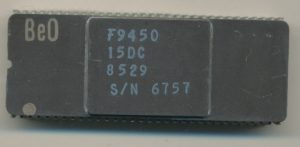
Fairchild F9450-15DC – MIL-STD-1750A processor based on the architecture of the F9445
Interestingly the F9445 provided the base for another Fairchild processor. The F9445 took Nova instructions, decoded them and ran them on its hardware, it was, in other words, a micro-coded processor. Microcoded processors can be useful as the microcode can be changed to support an entirely different instruction set. That’s exactly what Fairchild did with the F9450, a processor designed to execute the just released MIL-STD-1750A 16-bit instruction set.
Data General was not pleased, so again sued, claiming that Fairchild probably stole proprietary information in order to design the F9445. Fairchild was not alone in the action as their were other companies who made Nova emulating hardware, as well as those who made software that would run on a Nova. The lawsuits (no less then 11 of them) continued well into the 1980’s. By 1986 Data General was struggling, the case continued, and was not going in their favor. In September of 1986, a month before the trial for damages was to begin, Data General settled, paying Fairchild $52.5 million. Eight years after the fireworks began, the original F9440 MICROFLAME had not been made in years, the Nova 2 and Nova 3 were no longer made as well. The lawsuits destined the F9440 and the F9445 to failure, but they made their mark in setting precedent in lock-in, and how Instruction Sets can be used.
Read More »


